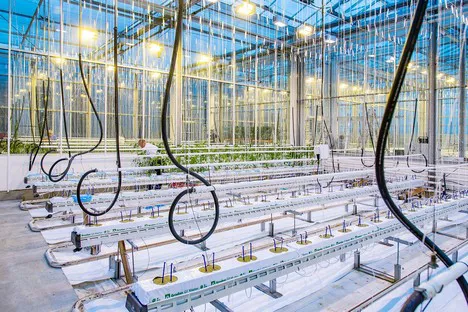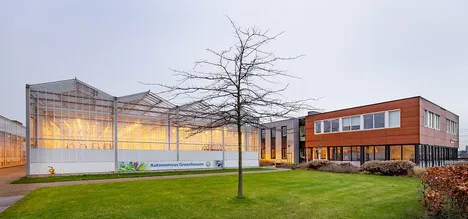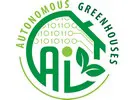Tomatoes are planted in the greenhouses of the 2nd Autonomous Greenhouses Challenge. Growing tomatoes with artificial intelligence (AI) in autonomous greenhouses, even from the other side of the world: Monday 16 December, the young tomato plants of five international teams that compete in the Autonomous Greenhouses Challenge were planted in the experimental greenhouses of Wageningen University & Research in Bleiswijk. The goal is to grow cherry tomatoes remotely with good taste and little energy using AI algorithms. Will the computer beat the greenhouse grower?
Sensors in, growers out
Five international teams (DIGILOG, IUA.CAAS, Automatoes, The Automators and AiCU) will produce a cherry tomato crop remotely during the next half year. With as little input as possible in water, nutrients, energy and CO2 and with maximum production and fruit quality, they will optimize the net profit.
Each team has a compartment of 96 m2 available in the high-tech greenhouses of Wageningen University & Research in Bleiswijk. The teams have made their own AI algorithms and will use them to determine the set points for temperature, amount of natural and artificial light, heating, CO2 concentration, fertigation and a number of cultivation-related parameters such as plant and stem density and fruit pruning.
Next to given standard sensors, the teams are allowed to install their own sensors in the week of 16 December. These are sensors and cameras to measure additional crop, climate and fertigation related parameters. The respective information are received by the teams via a digital interface. At the same time teams send – based on their AI algorithms – setpoints back to the process computer, which finally takes the action on climate and fertilization in the experimental greenhouse.
The teams are not allowed to enter the greenhouses themselves. The teams extract all data remotely and may adjust their algorithms for the software gradually. The software itself must adjust the set points if necessary. That way self-learning software can gradually take over people's decisions.

Credit: Wageningen University & Research
Cucumbers
In the first edition of the Autonomous greenhouse challenge in 2018, teams grew a greenhouse cucumber crop during a 4-month period with their AI algorithms. This first edition has resulted in a successful benchmark experiment demonstrating that AI algorithms can control greenhouse climate, irrigation and crop growth remotely. The winning team outperformed experienced manual growers.
Cherry tomato as experimental crop
In addition to the AI controlled greenhouses of the five teams, there is a sixth greenhouse compartment in which a group of Dutch growers will grow their tomatoes manually. That greenhouse serves as a reference.
In this second edition cherry tomato is the chosen crop because fruit quality and taste is an additional important parameter. Teams can control as well yield as fruit quality with their cultivation strategies and therefore influence net profit actively. E.g. Increasing light intensity and controlling light spectrum will have an effect on yield and fruit quality but also on electricity consumption. E.g. Increasing nutrient concentration (EC) will increase fruit quality but decrease yield.
A nursery has grown the young plants for the teams, people from the WUR Greenhouse Horticulture research station will place the plants in the autonomous greenhouses. A support team from WUR Greenhouse Horticulture will assist the teams with the necessary digital information. WUR employees will harvest the crops themselves and pass on standard crop information, such as the harvest weight and fruit quality, to the teams.

Credit: Wageningen University & Research
Evaluation criteria
An international jury will monitor the process and award points to the teams. "The teams receive 50% of the points for the net profit. They must maximize that net profit. They receive 20% of the points for sustainability: energy and water consumption and CO2 content. In addition, 30% of the points can be earned with the artificial intelligence approach.
The questions "how autonomously did the teams ultimately grow" and "how realistic is it to use this system on a large scale robustly" are central to this and are judged by the jury at the end.
The Autonomous Greenhouse Challenge is supported by a series of companies: Tencent providing main sponsoring, Heliospectra providing LED lights for all teams, Grodan providing root zone sensors, LetsGrow.com making the digital interface between standard sensor data, greenhouse control and AI algorithms of teams, Axia Seeds providing the cherry tomato seeds and KPN supporting in digital connection.
GreenTech
The winner of the challenge will be announced during the second week of June 2020 during the GreenTech 2020 at RAI Amsterdam.
For more information: Autonomous Greenhouses Challenge
Autonomous Greenhouses Challenge
www.autonomousgreenhouses.com
